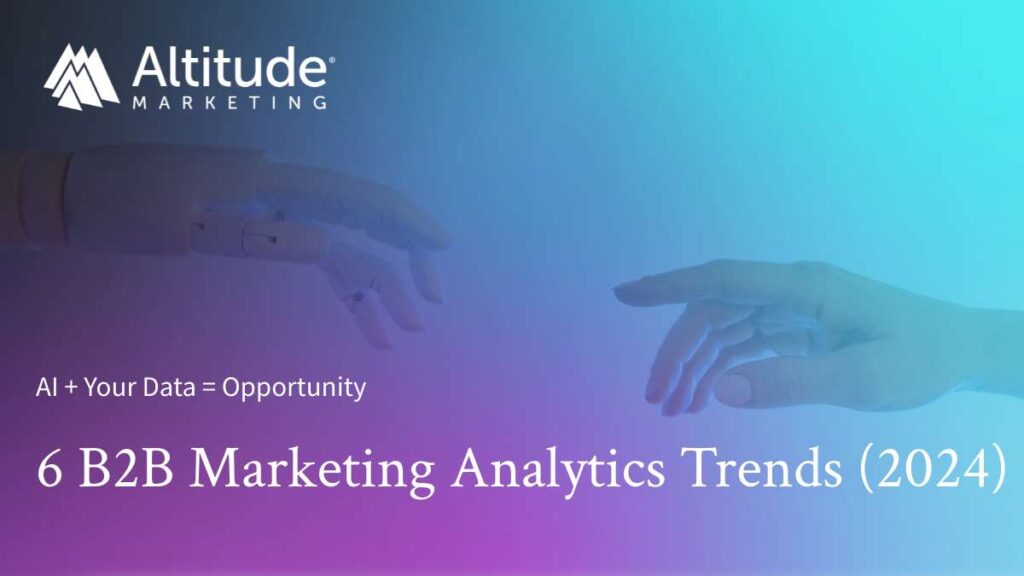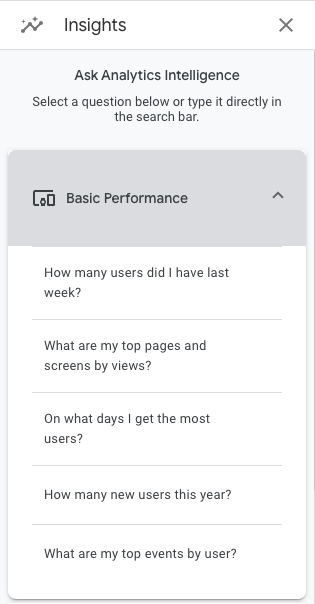Business-to-business (B2B) marketing analytics empowers you to understand your marketing efforts’ impact better. And new technologies are transforming how you interpret and leverage that data. Let’s explore six trends that will shape B2B marketing analytics in 2024 and beyond.
What Is B2B Marketing Analytics?
B2B marketing analytics measures and analyzes key performance indicators (KPIs) and metrics specific to B2B marketing objectives. These analytics provide valuable insights related to:
- Customer behavior
- Marketing ROI
- Campaign performance
- Lead generation
- Customer acquisition and retention
- Overall marketing effectiveness
Your organization can make informed decisions and optimize its B2B marketing efforts by leveraging data-driven insights. And if you’re like most B2B marketers, you learned how to utilize B2B marketing analytics through Universal Analytics.
The Impact of Universal Analytics & Google Analytics 4
Universal Analytics
Universal Analytics (UA) served as the standard for B2B marketing analytics for over a decade. As the third iteration of Google Analytics, UA provided website owners with valuable insights into user behavior, traffic sources, conversions and other metrics.
While UA had its benefits, it also led to some problems. Many website owners became hyper-focused on visitor stats like:
- Bounce rate: The percentage of website visitors who leave a website or webpage after viewing only a single page.
- Time on page: How long a website visitor spends on a single webpage.
- Time on site: How long a website visitor spends on a website.
While these metrics weren’t inherently bad, they didn’t always tell the full story of what was happening on the website. For example, a user who spent five minutes reading a blog post before leaving the site could count as a bounce. If a marketer saw that, they may think the blog post was underperforming and question whether visitors were interested in their content.
Google Analytics 4
As user behavior evolved and digital platforms expanded beyond websites, Google sunsetted UA in July 2023 in favor of Google Analytics 4 (GA4) as the next generation of its analytics platform. GA4 offers more advanced features, including enhanced cross-platform tracking, deeper integration with Google Ads, improved data modeling and a stronger focus on user privacy and consent.
What does this mean for B2B marketers? It means many have to relearn what they used to call analytics. While UA was more focused on sessions, GA4 is interested in events. KPIs like bounce rate still exist in GA4, but they’re heavily deemphasized in favor of user-focused analytics.
This all boils down to the transformation of raw data into actionable analytics. GA4 aims to help you separate meaningful data from noise. But if the old tactics of UA are no longer relevant, how can modern marketers rebuild their analytics strategies and make them even smarter? Let’s explore six trends to help you do just that in 2024.

6 Major B2B Marketing Analytics Trends for 2024
- GA4 Makes Analytics Easier to Understand
- Machine Learning Platforms and Tools Are More Accessible
- Intersectional Data Provides a Deeper Level of Targeting
- Customer Experience and Journey Modeling Tell a Clearer Story
- AI Continues to Evolve
- First-Party Data Helps Draw Actionable Insights
1. GA4 Makes Analytics Easier to Understand
Generative AI has recently exploded in popularity because it can generate new and original content, such as images, text or even music, with a simple prompt. Rather than simply analyzing or reproducing existing data, generative AI uses machine learning algorithms to create novel outputs based on patterns and examples found in a given dataset.
GA4 leverages generative AI to identify key segments and audience characteristics, such as demographics or user preferences, without requiring manual segmentation. This streamlines the process of uncovering audience insights, making it easier for businesses to understand their users and tailor their strategies accordingly.
For example, if you want to see your top events by user, you can simply click on “Insights” and select a pre-populated question or type in your own question. You’ll receive an answer in seconds, saving you time and manual resources.

In the past, you would need to understand data science and specific terminology in order to uncover answers in your data. GA4 makes B2B marketing analytics dramatically easier to understand and empowers the user to make a decision based on the information provided.
2. Machine Learning Platforms & Tools Are More Accessible
Machine learning enables computers or systems to learn and make predictions or decisions without being explicitly programmed. It involves developing algorithms and models that adapt and improve over time as they are exposed to more data.
B2B marketers can use machine learning platforms and tools to write marketing content, design images, and more. And the great part is there are many machine learning programs available in this day and age that you can utilize for your own B2B marketing analytics efforts.
For example, TensorFlow is an open-source machine learning framework developed by Google. It provides a comprehensive ecosystem for building and training various types of machine learning models, including deep learning models.
You can use TensorFlow to create simple models for Google Sheets. Simply create a spreadsheet, fill it in with your data, and use that data to train the machine learning model. From there, you can use TensorFlow to predict the data of an empty cell, which can help you predict future trends. And if you look at modeling based on keyword ranking, you can see possible conversions based on individual page traffic. It’s a revolution of “what-if” modeling.
3. Intersectional Data Provides a Deeper Level of Targeting
Intersectional data considers individuals’ intersecting identities and characteristics to inform marketing strategies, campaigns and targeting efforts. It involves analyzing data that captures the various dimensions of identity, such as:
- Race
- Gender
- Age
- Socioeconomic status
- Ethnicity
By leveraging intersectional data, B2B marketers can move beyond broad generalizations and stereotypes and develop marketing initiatives that better connect with diverse audiences.
For example, instead of assuming all women or all individuals of a particular race have the same preferences or needs, intersectional data considers how the intersection of gender and race, among other factors, might influence consumer behaviors and preferences. This allows you to create more targeted and relevant messaging and products that address the unique challenges of different intersectional segments.
4. Customer Experience & Journey Modeling Tell a Clearer Story
Customer experience and journey modeling is the process of mapping and analyzing the end-to-end journey of a customer’s interactions and experiences with a business or brand. It involves understanding the various touchpoints, channels and interactions that a customer goes through from initial awareness to post-purchase stages.
In B2B marketing analytics, there’s a tendency to start with a path you want the customer to take on their journey. But sometimes, that path isn’t the right fit for every customer. So, there’s an increased emphasis on truly understanding what a successful path looks like and why it’s the most attractive path for each customer.
With GA4’s plethora of data and models, you can better understand where your path veers off course. Are there too many touchpoints? Are you asking customers to buy before you show a demo? Is there content being ignored?
For example, let’s say you send 20 emails to folks at the top of your sales funnel. You notice the conversion happens between emails 6-8. Using your GA4 data, you can draw conclusions based on your information to make better decisions that increase your chances of a sale.
5. AI Continues to Evolve
AI’s impact on B2B marketing will continue to grow as technology advances and data becomes more accessible.
It’s important to note that we’re not just referring to generative modeling, such as ChatGPT. Instead, we’re highlighting the emergence of no-interface technology, which enables marketers to ask questions directly to AI-powered applications without requiring coding expertise.
This means that B2B marketers can quickly obtain data-backed answers to their inquiries, empowering them with actionable insights without the need for extensive data science knowledge. AI underpins all of this and makes for an exciting future.
6. First-Party Data Helps Draw Actionable Insights
First-party data is information a company collects directly from its customers or users. It’s often gathered through interactions with individuals, typically from its website, mobile app or other touchpoints. First-party data is considered highly valuable in marketing because it comes directly from the source, enabling you to have a deeper understanding of your customers so you can personalize your marketing efforts.
In GA4, all you see is real-world data available to you through personally identifiable information (PII) or automated website traffic tracked through cookies. Your company owns and controls this data, ensuring privacy compliance and data security.
You can have GA4 take all of that first-party data and build an audience for you based on the specific parameters and segments you set up, such as customer attributes, behaviors and interactions. This transforms how B2B marketers and website professionals look at analytics because you can draw real insights about your audience to understand their needs and take real action directly from that first-party data.
For example, you can use your first-party data to understand your customers’ needs and pain points. These insights can inform content creation, campaign optimization and overall marketing strategies to ensure they align with the audience’s expectations and goals.
Conclusion
B2B marketing analytics is entering a fascinating time of innovation, as new technologies give you the information you need to understand better how your marketing efforts are truly performing.
And by utilizing GA4, machine learning platforms, intersectional data, customer experience and journey modeling, no-interface technology and first-party data, you can set your organization up for success in 2024.



